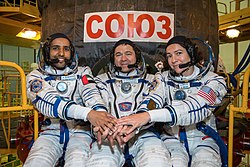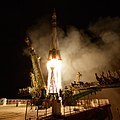Sojus MS-15
| Missionsdaten | |||||||
|---|---|---|---|---|---|---|---|
| Mission | Sojus MS-15 | ||||||
| Raumfahrzeug | Sojus 7K-MS (GRAU-Index 11F732) Seriennummer 744[1] | ||||||
| Rufzeichen | Сармат („Sarmat“) | ||||||
| Trägerrakete | Sojus FG (GRAU-Index 11A511FG) | ||||||
| Besatzung | 3 | ||||||
| Start | 25. September 2019, 13:57:43 UTC[2] | ||||||
| Startplatz | Baikonur 1/5 | ||||||
| Raumstation | ISS | ||||||
| Andockplatz | Swesda | ||||||
| Ankopplung | 25. September 2019, 19:42 UTC[3] | ||||||
| Abkopplung | 17. April 2020, 01:53 UTC[4] | ||||||
| Dauer auf ISS | 204d 6h 11min | ||||||
| Landung | 17. April 2020, 05:16 UTC[4] | ||||||
| Landeplatz | 149 km SO von Schesqasghan, Kasachstan, (47° 17′ N, 69° 33′ O) | ||||||
| Flugdauer | 204d 15h 19min | ||||||
| Erdumkreisungen | 3280 | ||||||
| Mannschaftsfoto | |||||||
 Hassa al-Mansuri, Oleg Skripotschka und Jessica Meir | |||||||
| ◄ Vorher / nachher ► | |||||||
| |||||||
Sojus MS-15 war ein Flug des russischen Sojus-Raumschiffs zur Internationalen Raumstation (ISS). Im Rahmen des ISS-Programms trägt der Flug die Bezeichnung ISS AF-61S. Es war der 167. Flug im Sojus-Programm und der 60. Besuch eines Sojus-Raumschiffs an der ISS.
Missionsbeschreibung
Die Mission brachte zwei Mitglieder der Expeditionen 61 und 62 zur ISS. Zusätzlich war ein Kurzzeitteilnehmer aus den Vereinigten Arabischen Emiraten an Bord, der nach einer Woche mit Sojus MS-12 zurückkehrte. Es handelte sich um den ersten Weltraumflug eines Astronauten aus den Emiraten.
Mit Sojus MS-15 kam letztmals die Raketenversion Sojus-FG zum Einsatz, die im Mai 2001 ihren Erststart absolvierte.[5] Die nachfolgende Mission Sojus MS-16 startete mit der neueren Sojus-2.1a. Da die Sojus 2.1 einen anderen Startplatz nutzt, endete mit MS-15 vorerst auch die Verwendung des historischen „Gagarin-Startplatzes“, der Startrampe 1/5 des Kosmodroms Baikonur, von der aus Juri Gagarin 1961 mit Wostok 1 als erster Mensch ins All flog.[6] Nachdem befürchtet worden war, dass hiermit eine Ära der russischen Raumfahrt zu Ende gehen würde, gab der Roskosmos-Leiter Dmitri Rogosin im Juli 2019 bekannt, dass der Platz 1/5 nach dem MS-15-Start modernisiert und für die Sojus-2.1 nutzbar gemacht werden soll.[7]
Besatzung
Hinflug
Hauptbesatzung
- Oleg Skripotschka (3. Raumflug), Kommandant (Russland/Roskosmos)
- Jessica Meir (1. Raumflug), Bordingenieurin (USA/NASA)
- Hassa al-Mansuri (1. Raumflug, UAE/MBRSC)[8]
Ursprünglich war für den Astronaut aus den Emiraten ein Platz bei Sojus MS-12 reserviert. Der Fehlstart von Sojus MS-10 hatte jedoch Änderungen in der ISS-Missionsplanung zur Folge. Zuletzt hatten die USA versucht, wegen Verzögerungen bei der Entwicklung der neuen US-Raumschiffe Crew Dragon und CST-100 Starliner den dritten Sitz von Sojus MS-15 zu kaufen, was den ISS-Aufenthalt von al-Mansuri beziehungsweise al-Nejadi erneut aufgeschoben hätte.[9]
Ersatzmannschaft
- Sergei Ryschikow (2. Raumflug), Kommandant (Russland/Roskosmos)
- Thomas Marshburn (3. Raumflug), Bordingenieur (USA/NASA)
- Sultan al-Nejadi (1. Raumflug), Bordingenieur (UAE/MBRSC)[8]
Rückflug
- Oleg Skripotschka, Kommandant (Russland/Roskosmos)
- Jessica Meir, Bordingenieurin (USA/NASA)
- Andrew R. Morgan, Bordingenieur (USA/NASA, Hinflug mit Sojus MS-13)
Missionsverlauf
Der Flug startete am 25. September 2019 um 15:57 Uhr (MESZ) vom Kosmodrom Baikonur. Nach knapp sechs Stunden dockte das Raumschiff um 21:42 Uhr am Swesda-Modul der ISS an.
Das Abdocken geschah nach einer Rekord-Aufenthaltszeit von 204 Tagen am 17. April 2020 um 03:53 Uhr (MESZ); um 07:16 Uhr (MESZ) erfolgte die Landung der Raumkapsel in Kasachstan.[4] Anstelle von Hassa al-Mansuri aus den Emiraten, der bereits mit Sojus MS-12 zurückgekehrt war, landete der mit Sojus MS-13 gestartete Andrew Morgan mit Sojus MS-15.[10]
Galerie
- Der Rollout der Rakete am 23. September 2019
- Der Start am 25. September
- Ankunft an Swesda am selben Tag
- Hitzeschildabwurf der Landekapsel am 17. April 2020
- Die Landekapsel im Moment des Aufsetzens
- Die Crew mit den Helfern kurz nach der Landung
Siehe auch
- Liste der Sojus-Missionen
- Liste der bemannten Missionen zur Internationalen Raumstation
- Liste der bemannten Raumflüge
Weblinks
- Sojus MS-15 bei spacefacts.de
- Sojus MS-15 im Russian Space Web
Einzelnachweise
- ↑ Anatoly Zak: Russian space activities in 2019. In: Russian Space Web. Abgerufen am 9. März 2019 (englisch).
- ↑ Chris Gebhardt: Soyuz-FG retirement; Last launch from Gagarin’s Start lofts first Emirati astronaut. In: Nasaspaceflight.com. 25. September 2019, abgerufen am 25. September 2019 (russisch).
- ↑ Twitter-Nachricht von Anatoly Zak, 25. September 2019.
- ↑ a b c Touchdown! Expedition 62 Returns to Earth, Completes Station Mission. NASA, 17. April 2020 (englisch).
- ↑ Источник: на Байконур отправили последний "Союз" с украинскими деталями. In: RIA Novosti. 17. April 2019, abgerufen am 5. April 2019 (russisch).
- ↑ Stephen Clark: Russians ready unpiloted Soyuz capsule for launch. In: Spaceflight Now. 22. August 2019, abgerufen am 27. August 2019.
- ↑ Upgrade of Gagarin launch pad to begin after Sept. 25 - Roscosmos. TASS, 21. Juli 2019, abgerufen am 27. August 2019.
- ↑ a b MBRSC selects Hazzaa Al Mansoori as Prime Astronaut for ISS Mission. Emirates News Agency, 12. April 2019, abgerufen am 12. April 2019.
- ↑ Chris Bergin: NASA set to purchase more Soyuz seats to ensure uninterrupted access to the ISS. In: Nasaspaceflight. 15. Februar 2019, abgerufen am 5. März 2019 (englisch).
- ↑ US to Extend Use of Russia's Soyuz for ISS Missions Until April 2020 - Source. In: Sputnik News. 12. Februar 2019, abgerufen am 9. März 2019 (englisch).
Auf dieser Seite verwendete Medien
Backdropped by a blanket of clouds, the Soyuz TMA-7 spacecraft departs from the International Space Station carrying astronaut William S. (Bill) McArthur Jr., Expedition 12 commander and NASA space station science officer; Russian Federal Space Agency cosmonaut Valery I. Tokarev, flight engineer; and Brazilian Space Agency astronaut Marcos C. Pontes. Undocking occurred at 2:48 p.m. (CDT) on April 8.
The Soyuz MS-15 spacecraft is launched with Expedition 61 crewmembers Jessica Meir of NASA and Oleg Skripochka of Roscosmos, and spaceflight participant Hazzaa Ali Almansoori of the United Arab Emirates, Wednesday, Sept. 25, 2019 from the Baikonur Cosmodrome in Kazakhstan.
The Soyuz MS-15 spacecraft is seen as it lands in a remote area near the town of Zhezkazgan, Kazakhstan with Expedition 62 crew members Jessica Meir and Drew Morgan of NASA, and Oleg Skripochka of Roscosmos, Friday, April 17, 2020. Meir and Skripochka returned after 205 days in space, and Morgan after 272 days in space. All three served as Expedition 60-61-62 crew members onboard the International Space Station.
The Soyuz rocket is rolled out by train to the launch pad, Monday, Sept. 23, 2019 at the Baikonur Cosmodrome in Kazakhstan. Expedition 61 crewmembers Jessica Meir of NASA and Oleg Skripochka of Roscosmos, and spaceflight participant Hazzaa Ali Almansoori of the United Arab Emirates will launch September 25th on the Soyuz MS-15 spacecraft from the Baikonur Cosmodrome to the International Space Station.
In the Integration Building at the Baikonur Cosmodrome in Kazakhstan, spaceflight participant Hazzaa Ali Almansoori of the United Arab Emirates (left) and Expedition 61 crewmates Oleg Skripochka of Roscosmos (center) and Jessica Meir of NASA (right) pose for pictures Sept. 11 in front of their Soyuz MS-15 spacecraft. They will launch Sept. 25 on the Soyuz MS-15 spacecraft from the Baikonur Cosmodrome for a mission on the International Space Station.
The Soyuz MS-15 spacecraft is seen as it lands in a remote area near the town of Zhezkazgan, Kazakhstan with Expedition 62 crew members Jessica Meir and Drew Morgan of NASA, and Oleg Skripochka of Roscosmos, Friday, April 17, 2020. Meir and Skripochka returned after 205 days in space, and Morgan after 272 days in space. All three served as Expedition 60-61-62 crew members onboard the International Space Station.
The camera on the rear port of the Zvezda service module captures the Soyuz MS-15 spacecraft approaching for a docking.
Expedition 62 crew members Andrew Morgan of NASA, left, Oleg Skripochka of Roscosmos, center, and Jessica Meir of NASA sit in chairs outside the Soyuz MS-15 spacecraft after they landed in a remote area near the town of Zhezkazgan, Kazakhstan on Friday, April 17, 2020. Meir and Skripochka returned after 205 days in space, and Morgan after 272 days in space. All three served as Expedition 60-61-62 crew members onboard the International Space Station.
















